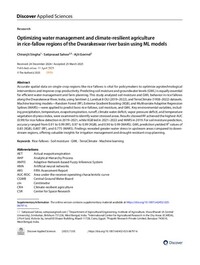Optimizing water management and climate-resilient agriculture in rice-fallow regions of the Dwarakeswar river basin using ML models

Authors:
Accurate spatial data on single-crop regions like rice fallows is vital for policymakers to optimize agrotechnological interventions and improve crop productivity. Predicting soil moisture and groundwater levels (GWL) is equally essential for efficient water management and farm planning. This study analyzed soil moisture and GWL behavior in rice fallows along the Dwarakeswar River, India, using Sentinel-2, Landsat 8 OLI (2019–2022), and TerraClimate (1958–2022) datasets. Machine learning models—Random Forest (RF), Extreme Gradient Boosting (XGB), and Multivariate Adaptive Regression Splines (MARS)—were applied to predict boro rice-fallows, soil moisture, and GWL. Key environmental variables, including precipitation, temperature, evapotranspiration, runoff, climate water deficit, vapor pressure deficit, and temperature vegetation dryness index, were examined to identify water-stressed areas. Results showed RF achieved the highest AUC (0.99) for rice-fallow detection in 2019–2021, while XGB led in 2021–2022 and MARS in 2019. For soil moisture prediction, accuracy ranged from 0.91 to 0.99 (RF), 0.97 to 0.99 (XGB), and 0.90 to 0.99 (MARS). GWL prediction yielded R2 values of 0.83 (XGB), 0.807 (RF), and 0.775 (MARS). Findings revealed greater water stress in upstream areas compared to downstream regions, offering valuable insights for irrigation management and drought-resistant crop planning.
